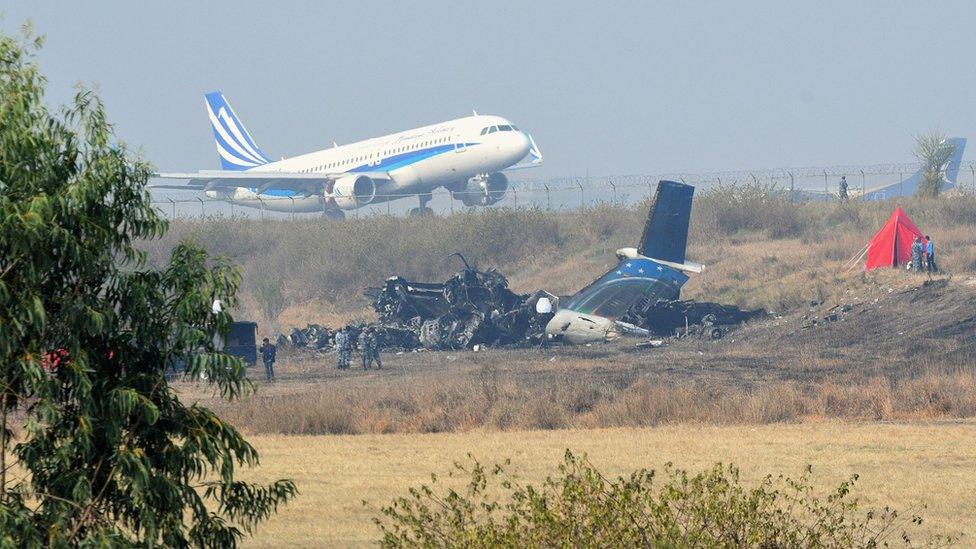Nepal plane crash: Were poor communications to blame?
- Published

This is the deadliest crash in Nepal since 1992
Experts say an audio recording of the last minutes of conversation between the pilots of the crashed plane in Nepal and the air traffic control shows signs of miscommunication.
The plane carrying 71 passengers and crew crashed on landing at Nepal's Kathmandu airport on Monday, killing 49 people.
Flight BS211, operated by Bangladeshi airline US-Bangla, veered off the runway while landing.
The exact cause of the crash remains unclear and an investigation has been launched. However, the recording suggests there could have been a misunderstanding over which end of the sole runway the plane was cleared to land on.
Captain Pawandeep Singh, a pilot with an Indian airlines, told the BBC that the recording showed that there was confusion in the cockpit.
"I am not sure what specifically happened in this case, but it seems like there was miscommunication while the pilot was trying to land the plane. But we will know the complete truth only when investigators file their report," he said.
'Confusion in cockpit'
Mr Singh added that "it seemed the pilot was trying visual landing".
"Usually, pilots use Instrument Landing Systems (ILS) to land aircraft, but in some scenarios they are allowed visual [manual] landing too where the runway is in pilot's vision. But such landings can be tricky in airports like Kathmandu," he said.
Aviation expert Greg Waldron said "unclear communications have been the cause of past crashes" as well.
"This is true of both ground to air communications, as well as crew communications in the cockpit. While the exact cause of this crash has yet to be determined, the Air Traffic Control (ATC) recordings suggest the crew was possibly disoriented and out of their comfort zone. This is a bad situation when coming in for a landing," he said.

The planed crash landed on Monday evening
Mr Singh, however, added that the language used in communications between pilots and ATCs is standardised around the world.
"We rarely face problems while communicating with ATCs anywhere in the world. And pilots always have to repeat the instructions, which leaves little room for confusion. Miscommunication can only happen with numbers - in this case the confusion seems to be between numbers 02 and 20 - which are markings on each end of the runway," he said.
Mr Waldron also said that the numbers can be confusing.
"Confusion unfortunately does happen, and pilots note that sometimes 02 and 20 can sound too similar over the radio. That said, the ground controllers appeared to give contradictory instructions prior to the aircraft's approach, switching from 02 to 20," he said.
'Tricky landing'
Mr Singh said another factor could have been the location of the airport in Kathmandu.
"Kathmandu is not the easiest airport to land because you have to navigate through mountains. Pilots have to go through special training to fly to Nepal. I have flown there and can tell you that's it's a busy airport," he said.

Normal flight operations have resumed at the airport
Basil Moses, a senior commander with Air India, further explained why landing at Kathmandu airport is considered difficult.
"Two sides of the airport are surrounded by mountains. There is a gap between the mountains to enter and exit. It's tricky for all pilots. It gets worse during nights and monsoons. Having said that, the weather was fine when the Bangla-US plane came in," he said.
- Published13 March 2018
